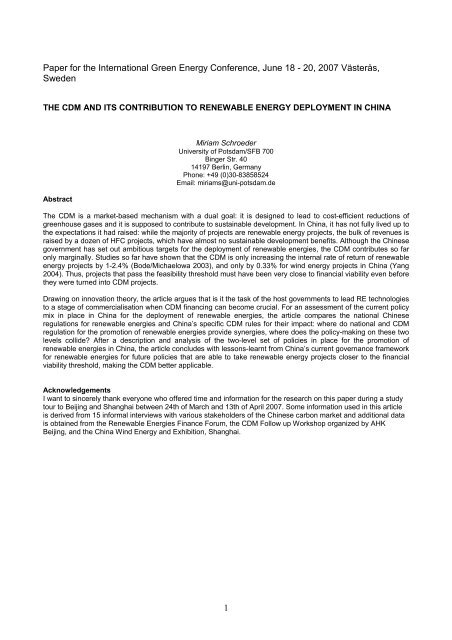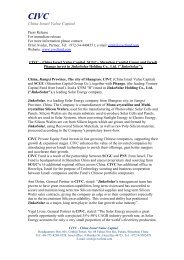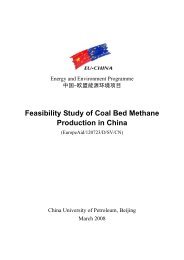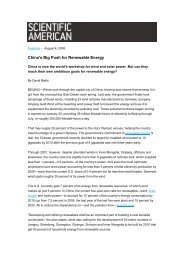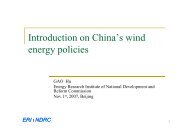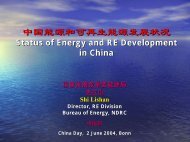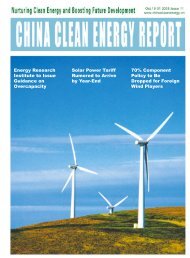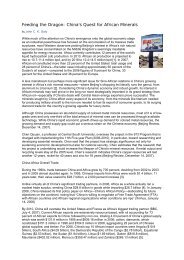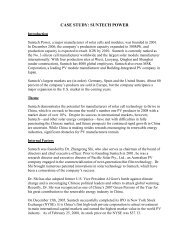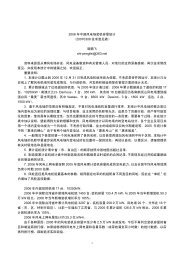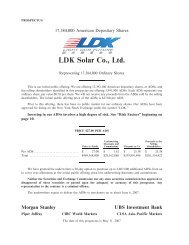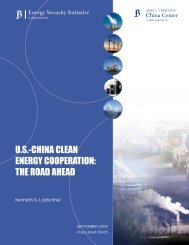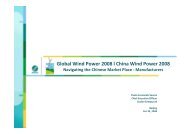20, 2007 Västerås, Sweden - Asia Europe Clean Energy (Solar ...
20, 2007 Västerås, Sweden - Asia Europe Clean Energy (Solar ...
20, 2007 Västerås, Sweden - Asia Europe Clean Energy (Solar ...
Create successful ePaper yourself
Turn your PDF publications into a flip-book with our unique Google optimized e-Paper software.
Paper for the International Green <strong>Energy</strong> Conference, June 18 - <strong>20</strong>, <strong>20</strong>07 <strong>Västerås</strong>,<br />
<strong>Sweden</strong><br />
THE CDM AND ITS CONTRIBUTION TO RENEWABLE ENERGY DEPLOYMENT IN CHINA<br />
Abstract<br />
Miriam Schroeder<br />
University of Potsdam/SFB 700<br />
Binger Str. 40<br />
14197 Berlin, Germany<br />
Phone: +49 (0)30-83858524<br />
Email: miriams@uni-potsdam.de<br />
The CDM is a market-based mechanism with a dual goal: it is designed to lead to cost-efficient reductions of<br />
greenhouse gases and it is supposed to contribute to sustainable development. In China, it has not fully lived up to<br />
the expectations it had raised: while the majority of projects are renewable energy projects, the bulk of revenues is<br />
raised by a dozen of HFC projects, which have almost no sustainable development benefits. Although the Chinese<br />
government has set out ambitious targets for the deployment of renewable energies, the CDM contributes so far<br />
only marginally. Studies so far have shown that the CDM is only increasing the internal rate of return of renewable<br />
energy projects by 1-2.4% (Bode/Michaelowa <strong>20</strong>03), and only by 0.33% for wind energy projects in China (Yang<br />
<strong>20</strong>04). Thus, projects that pass the feasibility threshold must have been very close to financial viability even before<br />
they were turned into CDM projects.<br />
Drawing on innovation theory, the article argues that is it the task of the host governments to lead RE technologies<br />
to a stage of commercialisation when CDM financing can become crucial. For an assessment of the current policy<br />
mix in place in China for the deployment of renewable energies, the article compares the national Chinese<br />
regulations for renewable energies and China’s specific CDM rules for their impact: where do national and CDM<br />
regulation for the promotion of renewable energies provide synergies, where does the policy-making on these two<br />
levels collide? After a description and analysis of the two-level set of policies in place for the promotion of<br />
renewable energies in China, the article concludes with lessons-learnt from China’s current governance framework<br />
for renewable energies for future policies that are able to take renewable energy projects closer to the financial<br />
viability threshold, making the CDM better applicable.<br />
Acknowledgements<br />
I want to sincerely thank everyone who offered time and information for the research on this paper during a study<br />
tour to Beijing and Shanghai between 24th of March and 13th of April <strong>20</strong>07. Some information used in this article<br />
is derived from 15 informal interviews with various stakeholders of the Chinese carbon market and additional data<br />
is obtained from the Renewable Energies Finance Forum, the CDM Follow up Workshop organized by AHK<br />
Beijing, and the China Wind <strong>Energy</strong> and Exhibition, Shanghai.<br />
1
INTRODUCTION<br />
Contribution of renewable energies to an avoidance of a carbon lock-in in China<br />
The deployment of renewable energies (RE) in China has a great potential for climate protection as RE can help to<br />
avoid a carbon-lock in of China’s energy production and instead foster a low-carbon development (Unruh/Carrillo-<br />
Hermosilla <strong>20</strong>06). In addition, RE deployment can reduce China’s increasing import dependence on fossil fuels.<br />
The Chinese government acknowledges the importance of RE for its energy security and has voiced ambitious<br />
targets: the current 8% share of RE in the total installed electricity generation capacity is supposed to be raised to<br />
10% in <strong>20</strong>10 and 16% in <strong>20</strong><strong>20</strong> (Zhang <strong>20</strong>05). Targets for wind energy are especially high: its installed capacity is<br />
supposed to reach 5 GW in <strong>20</strong>10 and 30 GW in <strong>20</strong><strong>20</strong>, increasing its capacity by more than 30 times from the<br />
current level of 1266 MW (He/Zhang <strong>20</strong>05; GTZ <strong>20</strong>05). RE are not new to China: wind mills have been used in<br />
rural areas since the 1980s, China is the world’s frontrunner in production and installation of solar thermal energy,<br />
and its local industry is quickly picking up in production and installation of solar cells and wind turbines.<br />
Nevertheless there is a huge gap between the current use of RE, the political ambitions and the technological<br />
potentials for RE in the country.<br />
Chart 1: Development and projections for the installed capacities of selected RE between <strong>20</strong>00-<strong>20</strong><strong>20</strong> in MW<br />
in MW<br />
1<strong>20</strong>000<br />
100000<br />
80000<br />
60000<br />
40000<br />
<strong>20</strong>000<br />
0<br />
<strong>20</strong>00 <strong>20</strong>01 <strong>20</strong>02 <strong>20</strong>03 <strong>20</strong>04 <strong>20</strong>05 <strong>20</strong>10 <strong>20</strong><strong>20</strong><br />
Source: AHK <strong>20</strong>06, GTZ <strong>20</strong>06b, Shi Pengfei <strong>20</strong>06<br />
2<br />
PV<br />
Wind<br />
Small Hydro<br />
This gap expands by the large need for investments in power generation capacity, which China faces in the next<br />
two decades (see chart 2 below). With the total power generation capacity increasing in size, the target of having a<br />
16% share of power production by RE in <strong>20</strong><strong>20</strong> would imply a large absolute growth for RE. However in China, but<br />
also in many other countries, renewable energy technologies face the dilemma of being politically wanted, but<br />
commercially unattractive. This is not true for all RE technologies in China: some of them, e.g. solar thermal and to<br />
some extent wind energy have already entered the stage of commercialisation (AHK Peking <strong>20</strong>06). Financial<br />
investment, e.g. by the <strong>Clean</strong> Development Mechanism (CDM) and adequate national political policies could<br />
greatly advance RE deployment by pushing them towards the stage of commercialisation.<br />
Chart 2: Electricity generation capacity needs<br />
Source: IEA <strong>20</strong>04
This article is a first attempt at examining the contribution the CDM has made so far for the deployment of<br />
renewable energies in China. It starts by giving a brief introduction to the background of the CDM, its contribution<br />
to the deployment of RE technologies worldwide and in China. In a second step, a model derived from innovation<br />
theory is introduced for an explanation of how government regulations impact on RE project risk. The final analysis<br />
compares the Chinese general regulations for RE deployment with the international and Chinese CDM specific<br />
requirements. The conclusion identifies synergies and contradictions between these two sets of regulations<br />
relevant for RE projects in China.<br />
USING MARKET-BASED MECHANISMS TO DEPLOY RENEWABLE ENERGIES<br />
The CDM as an instrument to finance low carbon development<br />
The CDM has been developed as a means to reduce greenhouse gas (GHGs) emissions cost-efficiently by<br />
allowing for emission reductions in developing and newly industrializing countries, which become credited for but<br />
also financed by industrialised countries of the Kyoto Protocol. The CDM is thus mainly a financing tool to lead<br />
investment into clean energy technologies, thereby contributing to the transition to a low carbon economy in<br />
developing countries. As RE are a major project category under the CDM, expectations are high that the CDM<br />
would also help to speed up the deployment of RE by providing finance, technology transfer and a demand for<br />
greenhouse gas reductions.<br />
The CDM is one of three flexible mechanisms of the Kyoto Protocol, which poses legally binding reduction targets<br />
for six greenhouse gases for industrialised countries. Agreeing on the principle of “common but differentiated<br />
responsibilities” industrialised countries committed themselves to make the first step of reducing GHG emissions<br />
as they had been contributing the most GHG into the atmosphere during their process of industrialisation. Listed in<br />
Annex I of the Kyoto-Protocol, these “Annex I countries” agreed on fixed emission reduction targets based on 1990<br />
emission levels for the first commitment period of <strong>20</strong>08-<strong>20</strong>12. Developing countries – referred to as “Non-Annex I<br />
countries” in the Kyoto Protocol - are not yet obliged to any fixed targets, but can become host countries to CDM<br />
projects. Each tonne of CO 2 equivalent reduced in a Non-Annex I country becomes – if all CDM requirements are<br />
met – registered as one “Certified Emission Reduction” (CER) and become tradable on the carbon market.<br />
The market for CERs has grown considerably since it was initiated by the coming into force of the Kyoto Protocol<br />
in February <strong>20</strong>05. An additional boost gave the initiation of the <strong>Europe</strong>an Emission Trading System (EU ETS) in<br />
January <strong>20</strong>05 that allocates emission allowances to <strong>Europe</strong>an companies responsible for high GHG emissions.<br />
The system of CDM and EU ETS are connected by the EU Linking Directive, which allows <strong>Europe</strong>an companies to<br />
meet up to 12% of their reduction obligations by buying CERs from CDM projects. Despite a clear mandate and<br />
the 2% administration charge on each CDM project devoted to a fund for CDM projects in least developed<br />
countries, the current CDM portfolio shows that the carbon market is bypassing the poorest countries and instead<br />
focuses on countries like China, India and Brazil, which offer less risk and more market potential.<br />
The CDM as a tool to promote renewable energies<br />
Renewable energies are central for the transition towards low carbon economies as they reduce the consumption<br />
of fossil fuels, which produce an average of 2.3 tonnes of CO 2 for each tonne of oil equivalent (Waller <strong>20</strong>04). As<br />
any other emission trading scheme, the CDM assigns a price on emission reductions, so that CERs become a<br />
commodity which can be traded and which provide an extra financial incentive to developers of RE projects in<br />
developing countries. While RE projects reduce GHG emissions on the supply side of electricity production,<br />
energy efficiency CDM projects are important to address energy consumption on the demand side. CDM projects<br />
reduce not only GHGs emissions cost-efficiently and enable Annex I countries to meet their emission reduction<br />
targets, but they can also be drivers for emerging RE markets in the CDM host countries. The CDM is a<br />
mechanism that provides not only additional finance, but also brings together project developers, validators, and<br />
project investors from developed and developing countries. While unilateral CDM projects are also allowed,<br />
bilaterally implemented CDM projects ideally should facilitate knowledge exchange and technology transfer among<br />
its partners and open up new business opportunities.<br />
Especially renewable energy projects deliver not only GHG emission reductions, but also sustainable development<br />
benefits to their local environment. In the context of the CDM, RE projects support local sustainable development<br />
e.g. by providing access to electricity and heating in remote areas or by creating jobs in the local RE industry. RE<br />
CDM projects should therefore be considered to be the core of the CDM project fleet, as the Kyoto Protocol<br />
mandates the CDM with a dual goal - GHG emission reduction and sustainable development – which RE and<br />
energy efficiency projects are best able to achieve.<br />
3
World wide achievements of the CDM in promoting renewable energies<br />
Exactly two years after the coming into force of the Kyoto Protocol, the CDM has proven to be successful in terms<br />
of project numbers: nearly 500 CDM projects in 55 host countries are registered and about 1000 CDM projects are<br />
under preparation. In June <strong>20</strong>06 the threshold of one billion tonnes of CO 2 equivalent ad the expected reduction<br />
volume of CERs up to <strong>20</strong>12 has been passed (UNFCCC <strong>20</strong>06), showing that the CDM is making a substantial<br />
contribution to the cost-effective reduction of GHGs.<br />
Concerning RE projects the contribution of the CDM needs to be differentiated along the following line: although<br />
renewable energy projects are the most common type of approved projects (see chart 3), they only generate about<br />
40 million or <strong>20</strong>% of all carbon credits up to <strong>20</strong>12 (see chart 4). In contrast, 40 million credits will be generated by<br />
two HFC-23 projects in China and 70 million – almost half of all credits – will be generated by a large N 2O project<br />
in South Korea (Fenhann <strong>20</strong>07). While these projects on industrial gases with a high potential of warming up the<br />
climate do contribute to climate protection, they do not deliver any sustainable development benefits.<br />
Chart 3: Share of renewable energy CDM<br />
projects of world’s total in February <strong>20</strong>07<br />
Source: Own calculation based on Fenhann<br />
01.02.<strong>20</strong>07<br />
The CDM and its contribution to renewable energy deployment in China<br />
China took a relatively slow start in the CDM market until institutions for the administration and approval of CDM<br />
projects had been set up. In the beginning of <strong>20</strong>07, China has caught up to such an extent that its CDM projects<br />
make up 19.9% of the world’s total (see chart 5), while the CERs generated up to <strong>20</strong>12 by Chinese CDM projects<br />
are expected to reach 47.2% of the total (see chart 6). Despite such a large share of China in the CDM market, the<br />
contribution of the CDM for a transition towards a low carbon economy has been low as 47% of all CERs<br />
generated in China come eleven CDM projects of HFC23 destruction.<br />
Chart 5: Share of no. of China’s CDM projects in<br />
world’s total in February <strong>20</strong>07<br />
Source: Own calculation based on Fenhann<br />
01.02.<strong>20</strong>07<br />
4<br />
Chart 4: Share of CERs up to <strong>20</strong>12 of<br />
renewable energy CDM projects in world’s total<br />
in February <strong>20</strong>07<br />
Source: Own calculation based on Fenhann<br />
01.02.<strong>20</strong>07<br />
Chart 6: Share of China’s CERs generated up to<br />
<strong>20</strong>12 in world’s total in February <strong>20</strong>07<br />
Source: Own calculation based on Fenhann<br />
01.02.<strong>20</strong>07
While China can account for a large share of the worldwide CDM market in general, the revenues derived from RE<br />
projects in China are relatively low. As the chart 7 below displays, only a percentage of 12% of China’s CERs are<br />
generated by renewable energy projects, despite their large number of 184 in February <strong>20</strong>07 (see chart 8)<br />
(Fenhann <strong>20</strong>07). This ratio of high revenues for a small number of HFC projects and low revenues for a large<br />
number of renewable energy projects signifies the major shortcoming of the CDM for the deployment of renewable<br />
energies: compared to other CDM project types, RE projects are not the most profitable ones.<br />
Chart 7: Share of CERs up to <strong>20</strong>12 of renewable<br />
energy CDM projects in China’s total in February<br />
<strong>20</strong>07<br />
Source: Own calculation based on Fenhann<br />
01.02.<strong>20</strong>07<br />
Although for-profit CDM market actors naturally choose to pick the “low hanging fruits” first, the absolute number of<br />
RE projects in the Chinese CDM portfolio raises optimism: the 184 RE projects make up 62% of all Chinese CDM<br />
projects. From such a high share, the conclusion must be that it is financially worthwhile also to invest in<br />
renewable energy CDM projects. However, the chart 7 also shows clearly the differences in attractiveness of<br />
renewable energy technologies and mirrors worldwide trends of RE investment: almost 50% of all CDM projects<br />
registered are wind power projects. In contrast, no single photovoltaic (PV) project has been established as a CDM<br />
project in China. The chart however also reflects general trends in worldwide CDM project type distribution: only<br />
seven out of 1586 projects in the pipeline involve PV. Based on these figures, one could conclude that the CDM is<br />
able to push many hydro and wind energy projects over the financial viability threshold, but so far no PV projects.<br />
Barriers to the CDM for financing renewable energies<br />
The figures of the status quo of the CDM in relation to RE projects show that while RE project are highest in terms<br />
of number, they do not generate the most revenue in terms of CERs. While it makes certainly sense to quickly<br />
phase out highly climate destructive gases like HFC23, the potential of RE (and energy efficiency) projects as<br />
drivers for a transition towards low carbon economies is not fully tapped in the present situation. Two main barriers<br />
can be identified why RE projects do not as good as they could in the present situation.<br />
1. Barrier: Low quantity of CERs versus high transaction costs<br />
Cost is one of the most obvious explanations for the lagging deployment of renewable energies in general.<br />
Unfortunately, this barrier for RE projects is also valid for CDM projects since they have higher transactions costs<br />
and gain less CERs than other CDM project types. Transaction costs for CDM emerge due to the CDM registration<br />
procedures. A project needs to be designed by a project developer, validated by a so called “Designated<br />
Operational Entity (DOE)”, approved by the host country, registered with the Executive Board, monitored during<br />
implementation, and GHG emission reductions need to be verified by a DOE before CERs are issued. In addition,<br />
all projects have to pay a 2% fee for the adaptation fund, which finances projects that help communities adapt to<br />
climate change. A registration fee ranging between 5000 and 30,000 USD has to be paid for each project<br />
depending on its size. As a consequence the thumb rule applies that the smaller the project, the higher the<br />
transaction costs.<br />
CERs are calculated based on projections of the emission reductions the CDM project is going to make. Since the<br />
six GHGs of the Kyoto Protocol are evaluated differently according to their potential to drive global warming, one<br />
prevented tonne of e.g. HFC 23 receives 12,000 CERs, while one prevented tonne of CO 2 receives only one CER.<br />
Because the profit margin becomes larger the more CERs are issued for a project, project developers and buyers<br />
have a strong preference of large CDM projects generating millions of CERs with low transaction costs. Since<br />
most RE projects produce only small amounts of CERs, they are at a comparative disadvantage compared to<br />
other types of CDM projects. There are also differences among RE projects with regard to their implementation<br />
and maintenance costs: hydro and wind power projects are often financially viable projects even without additional<br />
5<br />
Chart 8: Share of no. of renewable energy CDM<br />
projects in China’s total in February <strong>20</strong>07<br />
Source: Own calculation based on Fenhann<br />
01.02.<strong>20</strong>07
CDM financing, while even extra financing by the CDM is often not sufficient to lead to financial closure of solar<br />
projects. Prices for CERs from RE CDM projects vary according to project risk, the buyer, and on any additional<br />
quality requirements like the CDM Gold Standard. 1 With a current floor price of 5 USD/CER in China, the CDM<br />
does not provide much additional finance to RE projects. Studies so far have shown that the CDM is only<br />
increasing the internal rate of return of RE projects by 1-2.4% (Bode/Michaelowa <strong>20</strong>01) and by 0.33% for wind<br />
energy projects in China (Yang <strong>20</strong>04), while CDM financing can increase the IRR of biomass power generation<br />
projects by around 5%.<br />
2. Barrier: Dilemma of additionality<br />
The regulative rules for the CDM as set out in the Marrakesh Accords require CDM projects to be additional to the<br />
business-as-usual scenario. The additionality requirement is justified because it upholds the environmental<br />
integrity of the CDM process: only additional emission reductions can be accounted for the reduction targets of<br />
Annex I countries in order to ensure a global net reduction of GHGs. In practice, the project developer has to proof<br />
that the project under consideration would not have been implemented without the CDM. Evidence for the<br />
additionality can be achieved by one of three tests: CDM finance leads to financial closure; and/or the technology<br />
used for the CDM project us more advanced than the conventional technology; and/or any other barriers due to<br />
‘prevailing practice’ are overcome thanks to the CDM.<br />
Chart 9: Financial viability threshold of CDM<br />
projects<br />
As finance through the CDM increases the internal rate of<br />
return only marginally, projects have to be near to financial<br />
closure even without the CDM, but they must not be<br />
financially viable by themselves because this would<br />
disqualify them for the first additionality criterion. Even if in<br />
practice this dilemma is not posing a strict barrier for RE<br />
CDM projects yet, RE technologies like hydro, wind and<br />
solar thermal, which (almost) have reached the<br />
commercialisation stage, might face difficulties in proofing<br />
their additionality in the future.<br />
The additionality criterion was also cause for a ‘perverse’<br />
incentive by encouraging host countries not to implement<br />
progressive policies for renewable energies and energy<br />
efficiency. The reason was that national policies intended<br />
for the promotion of renewable energies change the<br />
“business as usual” scenario, thus diminishing the chances<br />
of CDM RE projects to become additional in the sense of<br />
using RE technology beyond the usual standard in the<br />
Source: Bode/Michaelowa <strong>20</strong>03<br />
country. This potential dilemma has been solved for the<br />
time being by a decision of the Executive Board of the<br />
CDM not to account national policies into the baseline calculation that have been implemented after November<br />
<strong>20</strong>01 in order not to “punish” national governments of developing countries that e.g. pass progressive policies for<br />
the deployment of renewable energies (UNFCCC <strong>20</strong>03).<br />
EFFECTIVE GOVERNANCE FOR RENEWABLE ENERGY DEPLOYMENT<br />
The description of the status quo of CDM RE projects worldwide and in China has shown that the CDM provides<br />
additional financing, but still faces barriers and cannot be considered to be the main driver of RE deployment.<br />
From a political scientific perspective, two main roads for a more effective deployment of RE technologies exist in<br />
the context of the CDM: either the member states of the Kyoto Protocol agree on measures that would give RE<br />
projects a preferential treatment under the CDM or each host country sets up a national regulatory framework that<br />
guides CDM investment into preferred project types. While an international agreement on preferential treatment of<br />
renewable energy projects is unlikely, experiences have shown that national regulations can develop synergies<br />
with the current CDM procedures for a more effective deployment of renewable energies. The following chapters<br />
will therefore first examine already existing assumptions in the literature about best practices for government and<br />
private actors to promote renewable energies. In a second step, the experiences and approaches of the Chinese<br />
government are described and analysed for their effects on RE CDM projects and for the general deployment of<br />
1 The CDM Gold Standard has stricter requirements for sustainable development impacts and community<br />
participation in CDM projects than required by the Kyoto Protocol. More information at: www.cdmgoldstandard.org<br />
[15.01.<strong>20</strong>07].<br />
6
RE technologies in China. This analysis will show whether national policies are able to steer the international CDM<br />
processes towards tapping more of the RE potential in China.<br />
Role of the CDM in the life-cycle of renewable energy deployment<br />
Innovation theory has become an extensive source for the debate about effective governance of renewable<br />
energies. Starting from the general debate on the relation between regulation and innovation (e.g. Frauenhofer<br />
<strong>20</strong>04), a discussion has emerged on the application of innovation theory for the deployment of RE for climate<br />
protection (e.g. Carbon Trust <strong>20</strong>03, Grubb <strong>20</strong>04, Stern <strong>20</strong>06). Scientists and practitioners share the viewpoint that<br />
a deployment of RE depends on a well-matched interplay between private and public incentives as a support for<br />
the commercialisation of renewable energies. According to innovation theory, technologies follow a life-cycle (see<br />
Chart 10) from their invention by research mainly funded by public money via a stage of commercialisation<br />
towards the final stage of diffusion in which a level playing field with conventional energy technologies is reached,<br />
easily measurable by the break-even point of costs compared to conventional energy production (Carbon Trust<br />
<strong>20</strong>03, Grubb <strong>20</strong>04). Once this stage is reached, the role for public incentives declines and the further diffusion of<br />
RE technologies is left to the ‘invisible hand’ of market forces.<br />
Chart 10: The life-cycle of RE deployment and the status of PV, Wind and solar thermal technologies in China<br />
Source: Adopted from Carbon Trust <strong>20</strong>03<br />
PV Biomass <strong>Solar</strong>thermal<br />
Wind<br />
Taking China as an example, the status quo of RE diffusion displays their position along the phases of the lifecycle<br />
model: PV is mainly covering niche markets (e.g. in remote areas without grid-connection) and thus is still in<br />
the demonstration phase. Wind energy has become competitive with conventional energy but only due to<br />
supporting government policies and finance, and has thus almost reached the commercialisation phase. Only<br />
solar thermal energy has reached the break-event point in China with no more need for government support and<br />
can thus be described as having reached full commercialisation status even if it has not yet become the “businessas-usual”<br />
scenario for water heating, which would identify solar thermal of being fully diffused (AHK Peking <strong>20</strong>06).<br />
The status of individual RE technologies in the life-cycle model has to be taken into consideration for designing an<br />
adequate governance strategy for their deployment. An almost 25-year-old scientific debate exists about the best<br />
policy instruments to strengthen deployment of RE. The debate draws mainly on the economic dichotomy of priceversus-quantity<br />
incentives (e.g. Mananteau et al. <strong>20</strong>02; Lewis/Wiser <strong>20</strong>07), and follows the overall trend to<br />
recommend market-based approaches for triggering innovation (e.g. Sonneborn <strong>20</strong>04). Critical voices doubt the<br />
transferability of economic instruments to countries with economies in transition and draw attention to the<br />
preconditions needed for such a transfer (e.g. Panayotou 1998, O’Connor 1996), especially in relation to RE<br />
(Kammen <strong>20</strong>04). The question of whether the preconditions are in place to make an instrument fully effective also<br />
applies to the CDM as a market-based instrument that is applied in newly industrialising and developing countries<br />
in which economies – and especially the energy sector – are just beginning to be transferred into a liberalised<br />
market.<br />
7<br />
Hydro<br />
Specific CDM<br />
rules<br />
CDM<br />
financing
The CDM is mainly a market-based instrument which – even if it was designed and brought to life by the state<br />
parties to the Kyoto Protocol – is intended to bring private investments from Annex I countries’ companies to RE<br />
projects in Non-Annex I countries. Private investment is attracted to CDM projects which give a decent rate of<br />
internal return, thus preferring RE technologies like wind and hydro, which are nearly fully commercialised. For this<br />
reason, the CDM becomes important for technologies which are in the phase of commercialisation, but are not yet<br />
fully diffused. If they would be fully diffused, meaning that they had reached the status of being the “business as<br />
usual” technology in a country, they might be even more attractive to private investors. However, projects that<br />
have reached full diffusion status would not be eligible any more as CDM projects because they would not be able<br />
to pass the additionality test of being either not financially viable by themselves or of using technology that is<br />
above the “business as usual”-scenario.<br />
If a government with ambitious plans for the deployment of renewable energies would like to attract CDM<br />
investment also for RE technologies that have so far been left out, its task would be to use policies to push the<br />
respective technology exactly to the status of deployment where it becomes commercially attractive, but is not yet<br />
able to reach financial closure by common sources of finance alone or is not yet the “business as usual”<br />
technology. Two options of raising the attractiveness of RE technologies for the CDM exist: general national<br />
regulation supporting RE can speed up their deployment process and specific CDM rules can steer foreign private<br />
investment into directions which are the priorities of the host government. Taking China as a case study, the<br />
remaining parts of the article examine the impact of national regulations and specific CDM rules on the contribution<br />
of the CDM to the deployment of RE.<br />
CHINESE POLICIES FOR THE DEPLOYMENT OF RENEWABLE ENERGIES<br />
With ambitious targets fixed for the deployment of RE at the national level, the Chinese government has passed<br />
several regulations independent from the CDM to increase the installed capacity of RE. China has already made<br />
some experiences with the employment of market-based policy instruments at the national level and has a set of<br />
Chinese CDM regulations tailor-made to steer financial investment in RE. Currently, the Chinese government is<br />
using policy instruments with an impact on RE projects on the macro- and micro-level of policy making:<br />
• National regulations set the general framework conditions for all renewable energy projects,<br />
• Chinese CDM regulations further set the specific rules for CDM projects such as approval procedures.<br />
This kind of two-level regulation is not always in harmony: both levels can create synergies when e.g. a heavy<br />
CDM fee on non-renewable projects is supposed to steer more investments into RE projects. Both levels can<br />
collide, if e.g. the Chinese CDM procedures request a 51% project ownership by domestic firms and a 70% local<br />
content of equipment, which is diminishing profit margins for foreign investors and is thus shrinking their potential<br />
engagement in RE projects. The puzzle is thus on the right mixture of national policies and CDM regulation to tap<br />
the whole potential of the CDM for the deployment of RE in China. In the following paragraphs, the Chinese<br />
national regulations with effect on the deployment of RE and China’s specific CDM rules are first described and in<br />
a second step analysed for their interplay.<br />
Policies for RE deployment at the national level<br />
The Chinese Renewable <strong>Energy</strong> Law. The Chinese Law for the Promotion of Renewable Energies (“RE law”) has<br />
become enacted since 1 January <strong>20</strong>06. In general, the RE law supports the deployment of wind-, solar-, biomass-,<br />
geothermal- and oceanic energy. Hydro power is regarded as eligible, but further guidelines for hydro power still<br />
need to be drafted. In its current form, the RE law includes mainly general guidelines for the deployment of<br />
renewable energies, which need to be further specified. Quantitative targets are supposed to be included in the<br />
guideline for „Mid- and Long-term Targets for Renewable Energies“(§7), which is supposed to guide the<br />
development of plans for the deployment of renewable energies on the national and the local level (§8).<br />
Subsequent to the RE law, an executive order on electricity prices („Pricing and Cost Sharing for Renewable<br />
<strong>Energy</strong> Power Generation“) has become effective since January 1 st , <strong>20</strong>06, and allows producers of electricity<br />
producers that use renewable energies to demand a higher tariff from grid operators in comparison to conventional<br />
power producers. Additional costs have to be borne by the grid operators and by consumers respectively.<br />
Local content requirement. The local content requirement of 70% on wind power plants came into force in <strong>20</strong>01<br />
with the objective of protecting the emerging national renewable energy industry. The local content requirement<br />
also applies to other RE technologies such as PV installations, gas turbines, desulphurization plants and highly<br />
efficient coal power plants, but varies in its percentage of local content requirement (NREL <strong>20</strong>04b).<br />
Favourable taxation. China is introducing tax reduction for companies in the renewable energy industry (see<br />
overview in table 1). The regular tariff for value-added tax in China is 17%, but it is discussed to delete it for<br />
8
enewable energy equipment. The income tax on revenues from biogas and wind power has already been reduced<br />
from 33% to 15%. Since <strong>20</strong>06, there is no more value-added tax on Ethanol.<br />
Table 1: Tax tariffs for selected renewable energy equipment<br />
Category Value-Added Tax (VAT) Value-Added Annex<br />
General 17% 8% of VAT 33%<br />
Biogas 13% 8% of VAT 15%<br />
Wind 8,5% 8% of VAT 15%<br />
Small hydro (
apparently paid into a China Climate Fund, which is still in the process of being set up. The fee on CDM projects<br />
imposed by China is innovative because it leads investment into China’s priority areas and because it diminishes<br />
the comparative disadvantage of RE project which are not taxed highly in comparison to N <strong>20</strong>, HFC, and PFC<br />
projects. From a governance perspective, the fee measure illustrates how a national government is able to bend<br />
an international regulation towards its own priorities.<br />
Government approval for CER price. In order to avoid selling emission reductions at dumping prices, the Chinese<br />
government requires its approval for CERs prices based on the criteria that CER prices must reflect international<br />
average (Bfai <strong>20</strong>06). Again, this interference by the government in negotiations between two private parties of a<br />
CDM project is unique in host countries’ measures to influence CDM implementation.<br />
Project ownership. The Chinese CDM rules require that a CDM project is to 51% owned by a Chinese company<br />
and restrict foreign ownership to 49%. This rule ensures Chinese firms keep controlling interest, but it limits risk<br />
management possibilities for foreign partners. For this reason, foreign companies currently are mainly found as<br />
mere buyers of CERs generated by CDM projects which have been conducted by Chinese companies and<br />
respective consultancies. Project that are only implemented for the reduction of greenhouse gases, e.g. landfill gas<br />
projects, which are more in need of foreign financial and technical assistance than projects for which CDM<br />
financing plays only a marginal role, are thus hampered by the 51% Chinese ownership rule.<br />
Synergies and contradictions between national regulations for the deployment of RE technologies and<br />
specific CDM rules for the deployment of RE in China<br />
The general Chinese regulations in general help to provide CDM project investors with relatively stable and<br />
predictable political framework conditions which reduce the country risk of projects. Targets for RE set in Chinese<br />
government plans give an indication of the current political stand towards RE, but their realisation depends on the<br />
effectiveness of governance at the provincial and local level for their implementation.<br />
Economic viability. Economic instruments like reductions on value-added and income tax for certain RE equipment<br />
and operation help to raise the internal rate of return of RE projects. Fixed feed-in-tariffs as promised by the RE<br />
law, will – if implemented – increase the profit security, making it easier for project owners to raise additional<br />
financing from credit institutions. On the other hand, the concession law on wind energy has disappointed many<br />
wind power developers who had hoped for fixed feed-in tariffs. Instead the concession law has led to a highly<br />
competitive price market for wind power that is in danger of dumping prices which cannot guarantee a successful<br />
delivery. However, the Wind concession law supports the Chinese wind turbine industry which on the price level is<br />
more competitive than the foreign wind turbine producers who might offer more advanced technology. Thus the<br />
wind power concession law is a typical example for the balancing act the Chinese government makes by trying to<br />
strengthen the local RE industry while simultaneously trying to attract foreign investment and technology transfer<br />
for the expansion of the Chinese capacity of RE power production. This dual approach is viable as long as it<br />
provides a middle route that still makes investment in Chinese RE projects attractive for foreign companies.<br />
Technology transfer. Both in the UNFCCC and in the Kyoto Protocol developed countries have committed<br />
themselves to the promotion of technology transfer to developing countries as a strategy to reduce greenhouse<br />
gases (UNFCCC article 4.5; Kyoto Protocol Article 3 and 11). In addition, the Chinese "Measures for Operation<br />
and Management of <strong>Clean</strong> Development Mechanism Projects in China" (www.ccchina.gov.cn) also demand in<br />
Article 10 that “CDM project activities should promote the transfer of environmentally sound technology to China”.<br />
Despite the call for technology transfer, the Chinese government is also aiming at protecting the emerging<br />
domestic renewable energy industry. Consequently, in <strong>20</strong>01, the law on a local content requirement of 70% for<br />
wind energy converters has been passed (NREL <strong>20</strong>04b). The local content requirement can also be fulfilled by<br />
establishing a Joint Venture with a Chinese production company or by selling the product license to a Chinese<br />
producer. However, the weak protection of intellectual property rights (IPRs) in China is often a barrier for Sinoforeign<br />
cooperation with high-tech equipment and limits technology transfer from foreign companies.<br />
Managerial capacity. The CDM provides new opportunities for cooperation between private actors from developing<br />
and developed countries, thereby facilitating the exchange of knowledge on technologies, project management<br />
and finance. CDM projects themselves but also the establishment of Chinese institutions responsible for CDM<br />
project approval on the national level and the set up of CDM Regional Centres on the provincial level has<br />
increased the knowledge base on CDM procedures and on renewable energy project management. In the private<br />
sector, the consultancy branch is growing due to the demand for experts on CDM project development, monitoring,<br />
verification and validation. Thus, the CDM has led to the emergence of a broad array of Chinese consultancies<br />
specialising on CDM project development (more information available at<br />
http://cdm.ccchina.gov.cn/english/ReferList.asp). On the other hand, the work of international project developers,<br />
consultancies and DOEs in China contributes to knowledge sharing. The internationally valid CDM rules on<br />
10
aseline setting, CER calculation, and project planning, monitoring and evaluation set new standards on<br />
renewable energy project development in China.<br />
Political risk. The mixture of internationally binding CDM approval criteria set up by the parties of the Kyoto<br />
Protocol and supervised by the CDM Executive Board and the national Chinese rules for CDM project<br />
implementation and approval gave more political security to the implementation of RE projects. Newly established<br />
institutions like the National CDM Board channel potential rivalries between ministries and the National<br />
Coordination Committee on Climate Change serves as a new information hub on rules and status quo of CDM<br />
projects in China. New is also the emergence of private sector associations for CDM projects like the China CDM<br />
Federation and the CDM Business Club with about 380 members (Bfai <strong>20</strong>06), which are an additional source of<br />
lobbying for effective CDM governance besides associations like the Chinese Renewable <strong>Energy</strong> Industry<br />
Association (CREIA) that is the nexus for information on RE in China. Information transparency on CDM projects<br />
has furthermore increased by the publication of the several CDM newsletters.<br />
CONCLUSION<br />
The article sets out to access the contribution of the CDM to the deployment of RE in China. Based on analysis on<br />
the contribution in terms of CDM project number and CDM project revenues an ambiguous picture emerged: while<br />
RE energy projects have the majority in China’s CDM project portfolio, the bulk of revenues from CERs are<br />
generated from a dozen HFC projects. Two main barriers hampering the full usage of the potential RE projects for<br />
the CDM have been identified: the cost-benefit ratio and the dilemma for CDM projects to proof their additionality.<br />
Because the CDM so far was not able to fully tap the potential of RE projects in China despite the positive political<br />
support towards RE as expressed in various Chinese targets for the future usage of RE, the article raised the<br />
question what policy measures the Chinese government might take to make more usage of the CDM. Drawing on<br />
innovation theory’s life-cycle model of the deployment of RE, the hypothesis was drawn that in order to make RE<br />
projects not yet fully considered by the CDM more attractive, the task of the government would be to push RE<br />
technologies towards a stage of commercialisation where they almost – but not fully – become financially viable.<br />
The second part of the article examines the Chinese national regulation and Chinese specific CDM rules in order<br />
to investigate what impact the current two-level governance has on the deployment of RE in China.<br />
Results show that governance for the deployment of RE at the national and at the CDM project level is not always<br />
in harmony, but can produce contradicting results: while the managerial capacity and the political risk of RE CDM<br />
projects is clearly strengthened by the two-level regulation, the financial project viability and the technical<br />
performance of projects is influenced by incentives that – in parts – contradict each other. One very successful<br />
policy measure has been the invention of the “royalty fees” on CDM projects which helps RE projects to reduce<br />
their comparative disadvantage to non-RE projects. A policy measure that has rather negative consequences for<br />
the tapping the full potential of the CDM is the local content requirement of 70% for RE equipment which – in<br />
conjunction with the allegedly poor intellectual property rights situation in China – hampers the technology transfer<br />
the CDM was supposed to deliver.<br />
One explanation to these findings is that the Chinese government takes a dual approach of attracting foreign<br />
investment and technology transfer while at the same time strengthening the local renewable energy industry.<br />
While both targets have their merits, their simultaneous pursuit has shown to cause some contradictions. A source<br />
for inspiration of how to combine both targets is China’s experiences with attracting foreign direct investment (FDI)<br />
in other sectors while fostering its own industry (Zhao/Michaelowa <strong>20</strong>06:1881). Successful practices from other<br />
sectors might then be taken as samples of how to design a multi-level governance framework for RE that is<br />
attractive for foreign CDM investment as well as for domestic industry development.<br />
While the article’s qualitative comparison of the two-level regulation leads to the conclusion that Chinese<br />
governance for the deployment of RE has contributed to push RE technologies towards commercialisation and<br />
thus making them more attractive for the CDM, further quantitative research examining details of the impact of<br />
these policies on the economic, technological and political project risk would shed more light on concrete causal<br />
connections between these policies and the deployment of RE in China.<br />
Ultimately, the deployment of RE in China and in other countries will not depend to a great extend on the usage of<br />
the CDM because it is financially contributing only little in comparison to investments needs for the energy<br />
infrastructure. Instead, the deployment of RE depends on an effective long-term governance for renewable energy<br />
exercised by an interplay of national governments and private actors. Thinking about options of who to make RE<br />
projects more preferential under the international CDM rules of the Kyoto Protocol is nevertheless a worthwhile<br />
task in order to come up with a comprehensive mechanism that is not only cost-effective, but also contributes to<br />
the transformation towards low carbon economies in developing countries.<br />
11
REFERENCES<br />
Albers, H., <strong>20</strong>05. Erwartungen des Bundesverbands Windenergie an den Windmarkt in China, TERNA Wind<br />
Expert Roundtable, 3 March <strong>20</strong>05, Eschborn, Germany.<br />
AHK Beijing. <strong>20</strong>06. Renewable energies in China – A market study on the wind and solar energy sector. Beijing.<br />
Bode, S. and A. Michaelowa. <strong>20</strong>03. Avoiding perverse effects of baseline and investment additionality<br />
determination in the case of renewable energy projects. <strong>Energy</strong> Policy 31: 505-517.<br />
Carbon Trust. <strong>20</strong>03. Inducing innovation for a low-carbon future: drivers, barriers and policies. London.<br />
Fenhannn, J., <strong>20</strong>07. CDM Pipeline 01.02.<strong>20</strong>07. Risø Centre.<br />
Fraunhofer Institut. <strong>20</strong>04. New Products and Services: Analysis of Regulations Shaping New Markets. Karlsruhe.<br />
Grubb, M., <strong>20</strong>04. Technology Innovation and Climate Change Policy: An Overview of Issues and Options. Keio<br />
Economic Studies 14:103-132.<br />
German Technical Cooperation (GTZ). <strong>20</strong>05. Energiepolitische Rahmenbedingungen für Strommärkte und<br />
erneuerbare Energien in der VR China. Eschborn/Beijing.<br />
German Technical Cooperation (GTZ). <strong>20</strong>06a. Liquid Biofuels for Transportation. Chinese Potential and<br />
Implications for Sustainable Agriculture and <strong>Energy</strong> in the 21st Century - Assessment Study. Beijing.<br />
German Technical Cooperation (GTZ). <strong>20</strong>06b. Information provided by Frank Haugwitz and Matthias Eifert, GTZ<br />
Bureau Beijing.<br />
Haugwitz, F., <strong>20</strong>06. VR China: Stand und Perspektiven für Erneuerbare Energien. Hannover Messe, 25 April <strong>20</strong>06.<br />
Hannover, Germany.<br />
He, J. and X. Zhang. <strong>20</strong>05. Strategies and Policies on Promoting Massive Renewable <strong>Energy</strong> Development.<br />
Working paper of the China Renewable <strong>Energy</strong> Development Strategy Workshop, 28 October <strong>20</strong>05.<br />
Tsinghua University, Beijing, China.<br />
Institute for Global Environmental Strategies (IGES), <strong>20</strong>05. CDM Country Guide for China. Kanagawa, Japan.<br />
Kammen M., D., <strong>20</strong>04. Renewable <strong>Energy</strong> Options for the Emerging Economy: Advances, Opportunities and<br />
Obstacles. The 10-50 Solution: Technologies and Policies for a Low-Carbon Future. Pew Center & NCEP<br />
Conference, 25-26 March <strong>20</strong>04. Washington, D.C.<br />
Ku, J. al., <strong>20</strong>05. The future is now - accelerating wind development in China. Renewable <strong>Energy</strong> World, July–<br />
August.<br />
Lewis I., J. and R. H. Wiser. <strong>20</strong>07. Fostering a renewable energy technology industry: An international comparison<br />
of wind industry policy support mechanisms. <strong>Energy</strong> Policy 35:1844-1857.<br />
Liu Y., <strong>20</strong>06a. Made in China, or Made by China? Chinese Wind Turbine Manufacturers Struggle to Enter Own<br />
Market. China Watch, World Watch Institute. Website: www.worldwatch.org/node/3931. Accessed on Jan.<br />
28, <strong>20</strong>07.<br />
Liu Y., <strong>20</strong>06b. Behind the Chilly Air: Impacts of China's New Wind Pricing Regulation. China Watch, World Watch<br />
Institute. Website: www.worldwatch.org/node/3904. Accessed on Jan. 28, <strong>20</strong>07.<br />
Mananteau, P., Finon, D. and M.-L. Lamy. <strong>20</strong>03. Prices versus quantities: choosing policies for promoting the<br />
development of renewable energy. <strong>Energy</strong> Policy 31:799-812.<br />
NREL. <strong>20</strong>04a. Renewable <strong>Energy</strong> Policy in China – Financial Incentives. Colorado.<br />
NREL. <strong>20</strong>04b. Renewable <strong>Energy</strong> Policy in China – Grid Connected Wind Power in China. Colorado.<br />
O’Connor, D.,1996. Applying Economic Instruments in Developing Countries: From Theory to Implementation.<br />
OECD Special Papers. Paris.<br />
Panayotou, T., 1998. Instruments of change – motivating and financing sustainable development. London:<br />
Earthscan.<br />
Prengel, R., <strong>20</strong>04. Risk Assessment and Mitigation in Renewable <strong>Energy</strong> Projects under the <strong>Clean</strong> Development<br />
Mechanism: Wind energy projects in China. Technical University Berlin: Diploma thesis.<br />
Shi P., <strong>20</strong>05. The View on China Future Wind Power Development. China Renewable <strong>Energy</strong> Development<br />
Strategy Workshop, 28 October <strong>20</strong>05. Tsinghua University, Beijing, China.<br />
Shi P., <strong>20</strong>06. National Presentation – China. Wind <strong>Energy</strong> Fair, 18 May <strong>20</strong>06. Hamburg, Germany.<br />
Sonneborn L., C., <strong>20</strong>04. Renewable energy and market-based approaches to greenhouse gas reduction –<br />
opportunity or obstacle? <strong>Energy</strong> Policy 32:1799-1805.<br />
Stern, N., <strong>20</strong>06. Stern Review on the economics of climate change. London: HM Treasury.<br />
UNFCCC, <strong>20</strong>03. Executive Board of the <strong>Clean</strong> Development Mechanism: Eleventh Meeting: Report. Bonn.<br />
UNFCCC, <strong>20</strong>06. Emission reductions from Kyoto Protocol’s <strong>Clean</strong> Development Mechanism pass the one billion<br />
tonnes mark. Press release of 6 June <strong>20</strong>06.<br />
Unruh C., G., and J. Carrillo-Hermosilla. <strong>20</strong>06. Globalizing carbon lock-in. <strong>Energy</strong> Policy 34:1185-1197.<br />
Waller-Hunter, J., <strong>20</strong>04. The Contribution of Renewable Energies in Meeting the Climate Change. International<br />
Conference for Renewable Energies, 1-4 June <strong>20</strong>04. Bonn, Germany.<br />
Wen, W., <strong>20</strong>06. Biofuels in China. <strong>Asia</strong> Biofuels Company (BVI), Ltd.<br />
Yang, M., <strong>20</strong>04. Climate change drives wind turbines in China: case study of market based wind power<br />
development. International Journal of Global <strong>Energy</strong> Issues, 21:99-109.<br />
Zhang G., <strong>20</strong>05. Speech at Minister Forum of Beijing International Renewable <strong>Energy</strong> Conference, 7 November<br />
<strong>20</strong>05. Beijing, China.<br />
12


